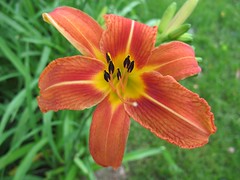My Life as a Creek

Why do I love Twitter? Let me count the ways… Okay, there are some Twitter cons (ie: a tempting time suck!) but the Twitter pros so totally outweigh them. There’s a fascinating sort of rhizomic community building that is unique from Facebook, Google Buzz, etc. But there’s something more compelling and yet more ellusive: the “twitter stream”. Sure, this reference gets bandied about in a variety of ways, and maybe some of the water metaphor’s sex appeal has been diluted along the way, but nobody seems to have coined a more apt alternative.
In just such an aqua-twitter mood the other day, I retweeted this: “just to drift… to be like a river…it is so important!” (RT @t2van via @conscire) Familiar allusions. Not earth shattering. Just a feeling, a yearning sent out into the either that resonated with others, that for a few brief seconds connected strangers. A common dream, a shared aspiration.
Shortly thereafter I received this response from Laura Munson(@Lauramunson):
“Read the Jim Harrison poem, Cabin Poem. Much to say about rivers in just a few perfect words.” ~ Laura Munson
It was Friday afternoon and I was headed off to opening night of Mrs. Farnsworth in Saranac Lake. I was running lines in my mind, driving through the Adirondack’s High Peaks. I wasn’t tweeting. Not much anyway! And I didn’t have time to look for Jim’s Harrison’s “Cabin Poem”. This morning I did. With two performances complete, and a tsunami of family and houseguests moving back out to sea, I’ve had time to sit down at my desk and begin catching up. And in the midst of catching up, I rememberd Laura’s recommendation, so I Googled Jim Harrison’s, “Cabin Poem” and read the brief but reflective poetry. Then reread it. Again and again. Then pushed my seat back from my cluttered desk and walked across my study to an arm chair, warm in the morning sun, and settled in to ponder while listening to the waves crashing against our dock house beyond the open window…
I’ve decided to make up my mind
about nothing, to assume the water mask,
to finish my life disguised as a creek,
an eddy, joining at night the full,
sweet flow, to absorb the sky,
to swallow the heat and cold, the moon
and the stars, to swallow myself
in ceaseless flow.
~ Jim Harrison, Cabin Poem
The strong Buddhist undertone aside, don’t you hear the Twitter overtone? I’ve certainly allowed myself to be swallowed in Twitter’s “ceaseless flow” more times than I care to keep track of. Which takes us back to where I started, to the pros and cons of this curious phenomenon called Twitter. It can be a tempting time suck. Yes. And sometimes that’s what we want and/or need, even when we resist admitting it. Swimming in a massive conversation about ideas that interest us, that connect us with others who are interested, interesting, challenging, educating, inspiring. Submitting to the “sweet flow”…
If you’re new to Twitter (or puffing out your chest for resisting that pointless waste of time) then you might not have had the opportunity to evaluate the rewards, the sheer joy of the sort of tweetalogue I’ve just recounted. Clearly Laura Munson, who I’ve never met, feels otherwise. And I’m grateful and richer for it! Thanks for guiding me to this insightful poem.












